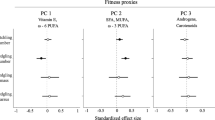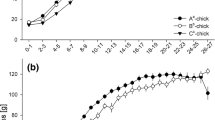Abstract
Parental decisions can determine offspring experience of environmental conditions. Such ‘maternal’ effects act both before and after hatching via, e.g., egg quality or the social milieu predisposed by parents. Resource availability may constrain the expression of adaptive maternal effects, and the specific pattern of allocation of these effects among offspring depending on their sex or birth order can result in different fitness payoffs to parents. Declining egg mass with laying order observed in several bird species may constitute an adaptive strategy of parental favouritism towards early hatching offspring with larger reproductive value but may also result from nutritional constraints on laying effort. A previous study has shown that the small size of the third, last laid (c-)egg in yellow-legged gull (Larus michahellis) clutches depends on food availability and that food-supplemented mothers increase the size of their female but not male c-eggs. Here, we show that increased mass of c-eggs laid by females supplemented with food after clutch initiation depends on increased albumen mass, which, in turn, enhances the size of daughters at hatching. Because asynchronous hatching results in a competitive disadvantage of c-chicks, present results suggest that mothers relieved from nutritional constraints enhance the size of daughters to compensate for their larger susceptibility to hatching last. The study also confirms the role of egg albumen content in determining hatchling size, previously experimentally detected only in one species in the wild. The effect of increased egg mass on offspring size persisted at least until day 8 after hatching, when, however, it did not vary with sex, suggesting intense negative selection on small female c-chicks in control broods. Hence, maternal effects mediated by egg albumen content had persistent effects on offspring size.




Similar content being viewed by others
References
Ardia DR, Wasson MF, Winkler DW (2006) Individual quality and food availability determine yolk and egg mass and egg composition in tree swallows Tachycineta bicolor. J Avian Biol 37:252–259
Arnold KE, Griffiths R (2003) Sex-specific hatching order, growth rates and fledging success in jackdaws Corvus monedula. J Avian Biol 34:275–281
Badyaev AV, Seaman DA, Navara KJ, Hill GE, Mendonca MT (2006) Evolution of sex-biased maternal effects in birds: III. Adjustment of ovulation order can enable sex-specific allocation of hormones, carotenoids, and vitamins. J Evol Biol 19:1044–1057
Blount JD, Surai PF, Nager RG, Houston DC, Møller AP, Trewby ML, Kennedy MW (2002). Carotenoids and egg quality in the lesser black-backed gull Larus fuscus: a supplemental feeding study of maternal effects. Proc R Soc London B 269:29–36
Bogdanova MI, Nager RG (2008) Sex-specific costs of hatching last: an experimental study on herring gulls (Larus argentatus). Behav Ecol Sociobiol 62:1533–1541
Bolton M, Monaghan P, Houston DC (1993) Proximate determination of clutch size in lesser black-backed gulls: the roles of food supply and body condition. Can J Zool 71:273–279
Bonisoli-Alquati A, Rubolini D, Romano M, Boncoraglio G, Fasola M, Saino N (2007) Effects of egg albumen removal on yellow-legged gull chick phenotype. Funct Ecol 21:310–316
Bonisoli-Alquati A, Martinelli R, Rubolini D, Saino N (2008) Sex-specific effects of albumen removal and nest environment manipulation on barn swallow nestlings. Ecology 89:2315–2324
Bortolotti GR (1986) Influence of sibling competition on nestling sex ratios of sexually dimorphic birds. Am Nat 127:495–507
Bradbury RB, Griffiths R (1999) Sex-biased nestling mortality is influenced by hatching asynchrony in the lesser black-backed gull Larus fuscus. J Avian Biol 30:316–322
Carey C, Rahn H, Parisi P (1980). Calories, water, lipid and yolk in avian eggs. Condor 82:335–343
Christians JK (2002) Avian egg size: variation within species and inflexibility within individuals. Biol Rev 77:1–26
Clark AB, Wilson DS (1981) Avian breeding adaptations: hatching asynchrony, brood reduction and nest failure. Q Rev Biol 56:253–277
Cordero PJ, Vinuela J, Aparicio JM, Veiga JP (2001) Seasonal variation in sex ratio and sexual egg dimorphism favouring daughters in first clutches of the spotless starling. J Evol Biol 14:829–834
Cramp S (1998) The complete birds of the Western Palearctic on CD-ROM. Oxford University Press, Oxford
Dufva R (1996) Blood parasites, health, reproductive success, and egg volume in female Great Tits Parus major. J Avian Biol 27:83–87
Fargallo JA, Laaksonen T, Pöyri V, Korpimäki E (2002) Inter-sexual differences in the immune response of Eurasian kestrel under food shortage. Ecol Lett 5:95–101
Fargallo JA, Polo V, de Neve L, Martin J, Dávila JA, Soler M (2006) Hatching order and size-dependent mortality in relation to brood sex ratio composition in chinstrap penguins. Behav Ecol 17:772–778
Ferrari RP, Martinelli R, Saino N (2006) Differential effects of egg albumen content on barn swallow nestlings in relation to hatch order. J Evol Biol 19:981–993
Finkler MS, van Orman JB, Sotherland PR (1998) Experimental manipulation of egg quality in chickens: influence of albumen and yolk on the size and body composition of near-term embryos in a precocial bird. J Comp Physiol 168:17–24
Groothuis TGG, Müller W, Engelhardt NV, Carere C, Eising C (2005) Maternal hormones as a tool to adjust offspring phenotype in avian species. Neurosci Biobehav Rev 9:329–352
Hill WL (1993) Importance of prenatal nutrition to the development of a precocial chick. Develop Psychobiol 26:237–249
Hillström L (1999) Egg mass variation and nestling growth in the pied flycatcher: a test of the brood reduction and the brood survival hypotheses. Evol Ecol Res 1:753–768
Hillström L, Kilpi M, Lindström K (2000) Is asynchronous hatching adaptive in herring gulls (Larus argentatus)? Behav Ecol Sociobiol 47:304–311
Hipkiss T, Hörndfelt B, Eklund U, Berlin S (2002) Year-dependent sex-biased mortality in supplementary-fed Tengmalm’s owl nestlings. J Anim Ecol 71:693–699
Howe HF (1978) Initial investment, clutch size and brood reduction in the common grackle (Quiscalus quiscula). Ecology 59:1109–1122
Järvinen A, Ylimaunu J (1986) Intraclutch egg-size variation in birds: physiological responses of individuals to fluctuations in environmental conditions. Auk 103:235–237
Kilpi M, Hillström L, Lindström K (1996) Egg-size variation and reproductive success in the herring gull Larus argentatus: adaptive or constrained size of the last egg? Ibis 138:212–217
Kim S-Y, Monaghan P (2006) Sex of the first hatched chick influences survival of the brood in the herring gull (Larus argentatus). J Zool 270:116–121
Love OP, Chin EH, Wynne-Edwards E, Williams TD (2005) Stress hormones: a link between maternal condition and sex-biased reproductive investment. Am Nat 166:751–766
Maddox JD, Weatherhead PJ (2008) Egg size variation in birds with asynchornous hatching: is bigger really better? Am Nat 171:358–365
Martinez-Padilla J, Fargallo J (2007) Food supply during prelaying period modifies the sex-dependent investment in eggs of Eurasian kestrels. Behav Ecol Sociobiol 61:1735–1742
Mead PS, Morton ML, Fish BE (1987) Sexual dimorphism in egg size and implications regarding facultative manipulations of sex in mountain white-crowned sparrows. Condor 89:798–803
Meathrel CE, Ryder JP (1987) Sex ratios of ring-billed gulls in relation to egg size, egg sequence and female body condition. Col Waterbirds 10:72–77
Monaghan P, Nager RG (1997) Why don't birds lay more eggs? Tends Ecol Evol 12:270–274
Mousseau TA, Fox CW (1998a) Maternal effects as adaptations. Oxford University Press, New York
Mousseau TA, Fox CW (1998b) The adaptive significance of maternal effects. Trends Ecol Evol 13:403–407
Müller W, Dijkstra C, Groothuis TGG (2003) Inter-sexual differences in T-cell-mediated immunity of black-headed gull chicks (Larus ridibundus) depend on the hatching order. Behav Ecol Sociobiol 55:80–86
O'Connor RJ (1979) Egg weight and brood reduction in the European swift (Apus apus). Condor 81:133–145
Oddie KR (2000) Size matters: competition between male and female great tit offspring. J Anim Ecol 69:903–912
Ojanen M, Orell M, Väisänen RA (1981) Egg size variation within passerine clutches: effects of ambient temperature and laying sequence. Ornis Fenn 58:93–108
Parsons J (1970) Relationship between egg size and post-hatching chick mortality in the Herring gull (Larus argentatus). Nature 228:1221–1222
Parsons J (1975) Asynchronous hatching and chick mortality in the herring gull Larus argentatus. Ibis 117:517–520
Reid WV (1987) Constraints on clutch size in the glaucous-winged gull. Stud Avian Biol 10:8–25
Ricklefs RE (1993) Sibling competition, hatching asynchrony, incubation period, and lifespan in altricial birds. In: Power DM (ed) Current ornithology. Vol 11. Plenum Press, New York, pp 199–276
Romano M, Caprioli M, Ambrosini R, Rubolini D, Fasola M, Saino N (2008) Maternal allocation strategies and differential effects of yolk carotenoids on the phenotype and viability of yellow-legged gull (Larus michahellis) chicks in relation to sex and laying order. J Evol Biol 21:1626–1640
Rubolini D, Romano M, Martinelli R, Saino N (2006) Effects of elevated yolk testosterone levels on survival, growth and immunity of male and female yellow-legged gull chicks. Behav Ecol Sociobiol 59:344–352
Rubolini D, Ambrosini R, Romano M, Caprioli M, Fasola M, Bonisoli-Alquati A, Saino N (2009) Within-clutch egg size asymmetry covaries with embryo sex in the yellow-legged gull Larus michahellis. Behav Ecol Sociobiol 63:1809–1819
Ruiz X, Jover L, Pedrocchi V, Oro D, González-Solís J (2000) How costly is clutch formation in the Audouin’s Gull Larus audouinii? J Avian Biol 31:467–575
Rydén O (1978) Egg weight in relation to laying sequence in a south Swedish urban population of the blackbird Turdus merula. Ornis Scand 9:172–177
Saino N, Romano M, Ferrari RP, Martinelli R, Møller AP (2003) Maternal antibodies but not carotenoids in barn swallow eggs covary with embryo sex. J Evol Biol 16:516–522
Saino N, Romano M, Ambrosini R, Ferrari RP, Møller AP (2004) Timing of reproduction and egg quality covary with temperature in the insectivorous Barn Swallow, Hirundo rustica. Funct Ecol 18:50–57
Saino N, Romano M, Ferrari RP, Martinelli R, Møller AP (2005) Stressed mothers lay eggs with high corticosterone levels which produce low-quality offspring. J Exp Zool 303A:998–1006
Saino N, de Ayala RM, Martinelli R, Boncoraglio G (2008) Male-biased sex ratio depresses average phenotypic quality of barn swallow nestlings under experimentally harsh conditions. Oecologia 156:441–453
Saino N, Romano M, Caprioli M, Ambrosini R, Rubolini D, Fasola M (2010) Sex allocation in yellow-legged gulls (Larus michahellis) depends on nutritional constraints on production of large last eggs. Proc R Soc London B 277:1203–1208
Salzer DW, Larkin GJ (1990) Impact of courtship feeding on clutch and third-egg size in glaucous-winged gulls. Anim Behav 39:1149–1162
Slagsvold T, Andvik J, Rofstad G, Lorentsen O, Husby M (1984) On the adaptive value of intraclutch egg-size variation in birds. Auk 101:685–697
Sotherland PR, Rahn H (1987) On the composition of bird eggs. Condor 89:48–65
Stenning MJ (1996) Hatching asynchrony, brood reduction and other rapidly reproducing hypotheses. Trends Ecol Evol 11:243–246
Stoleson SH, Beissinger SR (1995) Hatching asynchrony and the onset of incubation in birds, revisited. In: Power DM (ed) Current ornithology. Vol 12. Plenum Press, New York, pp 191–270
Török J, Hargitai R, Hegyi G, Matus Z, Michl G, Péczely P, Rosivall B, Tóth G (2007) Carotenoids in the egg yolks of collared flycatchers (Ficedula albicollis) in relation to parental quality, environmental factors and laying order. Behav Ecol Sociobiol 61:541–550
Uller T (2006) Sex-specific sibling interactions and offspring fitness in vertebrates: patterns and implications for maternal sex ratios. Biol Rev 81:207–217
Verboven N, Evans DM, Schwabl H, Evans N, Whitelaw C, Nager RG (2003) Maternal condition, yolk androgens and offspring performance: a supplemental feeding experiment in the black-backed gull (Larus fuscus). Proc R Soc Lond B 270:2223–2232
Viñuela J (1997) Adaptations vs. constraints: intraclutch egg-mass variation in birds. J Anim Ecol 66:781–792
Viñuela J (2000) Opposing selective pressures on hatching asynchrony: egg viability, brood reduction, and nestling growth. Behav Ecol Sociobiol 48:333–343
Williams TD (1994) Intraspecific variation in egg size and egg composition: effects on offspring fitness. Biol Rev 68:35–59
Author information
Authors and Affiliations
Corresponding author
Additional information
Communicated by J. Graves
Rights and permissions
About this article
Cite this article
Saino, N., Romano, M., Rubolini, D. et al. Food supplementation affects egg albumen content and body size asymmetry among yellow-legged gull siblings. Behav Ecol Sociobiol 64, 1813–1821 (2010). https://doi.org/10.1007/s00265-010-0993-1
Received:
Revised:
Accepted:
Published:
Issue Date:
DOI: https://doi.org/10.1007/s00265-010-0993-1




